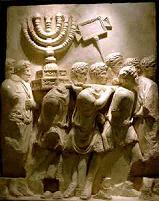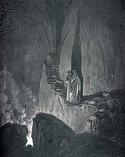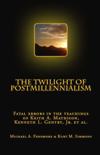The Day-Age Theory is Leading
Preterists Astray
Kurt Simmons
So then faith cometh by hearing, and hearing by the word of God. Rom. 10:17
The modern day Preterist movement was born out of intense Biblical study; it’s only inducement is the Bible. Although secular history corroborates and provides information of events after the close of the New Testament canon, they say nothing to the validity of Preterism itself. No one ever became a Preterist from reading the histories of Josephus, Tacitus, Suetonius, or Dio Cassius. Debates affirming the Preterist model never rely, and rarely introduce, extra-Biblical material in evidence of its truth. We stand upon the word of God.
In contrast, Old Earth Creationism (OEC) was born as an apologetic attempt to reconcile the Bible with the claims of naturalistic science. This is not an accusation, but a universally admitted fact. The sole inducement to OEC is exterior to the Bible; no one ever became an OEC based on reading Genesis or the Bible. Debates affirming OEC rely heavily, if not exclusively, upon extra-Biblical material; demonstrations of its “proofs” are long on naturalistic science and its dating methods, and short on Bible. Indeed, not one word can be produced from the Bible dating the earth to millions, let alone billions of years. The validity of OEC exists only by imposing upon the silence of the scripture. To be an OEC, one must be willing to believe what the Bible does not say, and contradict much of what it does.
How strange that some should attempt to wed these very different disciplines together. The one rooted in the Bible and supported exclusively by the word of God; the other rooted in atheistic science. One system is founded upon numerous, express statements placing the eschaton in the life of the apostles; the other has not a single verse that can be produced affirming its basic assumptions, and exists only in the space between the lines. Ask a Preterist to place upon paper all the verses affirming Christ returned in the events culminating in A.D. 70 and he will fill pages. Ask an OEC to place on paper all the verses demonstrating the earth is billions of years old and the paper will remain forever blank. And yet, there are those that would tell us that OEC is the logical consequence and bedfellow of Preterism; that Preterism actually proves OEC and vice versa!
Two Basic Models of OEC
There are two basic models of OEC: the “gap theory” and the “day-age” theory. We have dealt with the gap theory at length in an earlier article. (Sword & Plow, Oct. 2007) Briefly stated, this theory was developed in the early 19th century by Scottish theologian, Thomas Chalmers, in response to naturalistic theories regarding earth’s age based upon the so-called geologic column. In attempting to reconcile the Bible to naturalistic science, Chalmers proposed that there is “gap” between Gen. 1:1 and 2. Chalmers suggested that the earth was inhabited by man and animals hundreds of millions of years ago, but perished in a world-wide deluge, and that Adam is but the first man of the present, 2nd creation, which was accomplished in the space of six literal, twenty-four hour days. All the rage in its day, this theory has all but been abandoned by OEC’s who now opt for the “day-age” theory.
In the mid 19th century, American geologist Arnold Guyot sought to harmonize science and scripture by interpreting the "days" of Genesis 1 as epochs in cosmic history. Similar views were held by a protégé of Lyell, John William Dawson. Together these men are attributed with development of the “day age” theory. According to the day-age theory, the six days of creation are interpreted as vast ages, consisting of millions and billions of years. Justification for this is purportedly found in the Hebrew word yom. Proponents argue the term can mean an indistinct period of time. Hence, OCE’s argue that billions of years may be comprehended within the term. Here is how yom is defined:
Yom 1) day, time, year; a) day (as opposed to night); b) day (24 hour period); 1) as defined by evening and morning in Genesis 1; 2) as a division of time; a) a working day, a day's journey; c) days, lifetime (pl.); d) time, period (general); e) year; f) temporal references; 1) today; 2) yesterday; 3) tomorrow
Day-Age Theory: A Belief in What the Bible Does Not Say
Here, basic rules of hermeneutics and principles of translation enter in. Moses distinctly qualifies yom by the phrase “and evening and morning” followed by ordinal numbers - “And the evening and the morning were the first day.” (Gen. 1:5) A five year old could not mistake Moses’ meaning. Only someone unwilling to receive the truth would attempt to avoid the obvious meaning of these terms. Outside of Genesis, every time yom is used with a number (410 times), it refers to a literal day. Elsewhere, "evening" and "morning" show up with yom 23 times, and by themselves 38 times--each time referring to a literal 24-hour day. The term "night" is used with yom 53 times, similarly indicating a 24-hour day. Other Hebrew words (olam and qedem) could have been used to indicate periods of time here, but neither was used even once.
Faced with the complete inability to skirt the meaning of the term, OEC’s dismiss it as a mere symbol. They admit that a literal twenty-four hour day is signified, but interpret it as a symbol for something else instead; viz., geologic ages consisting of billions of years. However, here again basic rules of interpretation and hermeneutics frustrate their purpose. Before one thing may be made the symbol of something else, the author must so intend. So, what was Moses’ intension? Did he intend us to understand yom as a symbol, or did he intend it to be taken according to its normal meaning and purport? Here, there can be no mistake. The Jewish Sabbath stood as a testimony to the literalness of the creation account. The Jews were commanded to rest the seventh day just as God had rested: “For in six days the Lord God made the heaven, the earth, the sea, and all that in them is.” (Ex. 20:11) One could just about debate the whole question of the day-age theory on the strength on this one verse. There is virtually no avoiding its meaning; however cleverly some may argue for a figurative or poetic meaning in the Genesis, Moses here makes plain that the creation account was intended to be understood literally. The weekly Sabbath could have no meaning if the days of creation spanned billions of years, or the “seventh day” was an age that was on-going still. Certainly, four thousand years of sacred history show the creation account has nearly always been taken literally by God’s people, Jews and Gentiles. To cite just a couple examples:
Philo Judaeus – “And he said that the world was made in six days, not because the creator stood in need of a length of time (for it is natural that God should do everything at once, not merely by uttering a command, but by even thinking of it); but because the things created required arrangement…And he allotted each of the six days to one of the portions of the whole.”[1]
Flavius Josephus – “Accordingly Moses says that in just six days the world and all that is therein was made; and that the seventh day was a rest, and a release from the labour of such operations; - whence it is that we celebrate a rest from our labours on that day, and call it the Sabbath; which word denotes rest in the Hebrew tongue.”[2]
Epistle of Barnabas – “The Sabbath is mentioned at the beginning of the creation: ‘And God made in six days the works of His hands, and made an end on the seventh day, and rested on it, and sanctified it.’”[3]
Clement of Alexandria – “For the creation of the world was concluded in six days. For the motion of the sun from solstice to solstice is completed in six months--in the course of which, at one time the leaves fall, and at another plants bud and seeds come to maturity.”[4]
To this short list may be added many dozens of others,[5] all testifying to the traditional (historical) teaching from the time of Moses until now, that the chronology of Genesis is to be read literally. This does not prove the traditional interpretation is correct, but it does demonstrate circumstantially that the motive for reinterpreting Genesis stems from the claims of modern science, and not the scriptures themselves; for if the idea that billions of years had elapsed from the beginning was truly in the text, men would not have waited almost eighteen hundred years to discover it; the idea would have been present with men from the start, just as Preterism has been.
Creation According to Day-Age: Evolution Wrapped Up in Biblical Garb
In treating the days of creation as geologic ages, the day-age theory is guilty of embracing a type of theistic evolution. Moreover, it implicitly denies Adam’s universal, biological priority. Here is a sketch of typical day-age approach to creation; judge for yourself if we are not correct:
Day One: 10-20 billion years ago the “big bang” occurred, creating the universe. The universe today continues to expand due to that explosion. The earth was formed by a process called "accretion." Matter that revolved around the young sun soon began to accumulate into a distinct body. About 4.5 billion years ago, our world finally became a distinct planet; it was also uninhabitable. Around four billion years ago, the earth cooled to the point where steam could liquefy. This precipitated a great deluge. For millions of years, torrential rains poured down upon the surface of the earth, eroding the volcanic mountains and cutting valleys. Stable mountain ranges as we recognize them today did not exist at that time, because the process of plate tectonics had not yet begun. The surface of the earth was relatively smooth, and was soon covered by a global ocean. The precursors to life - and maybe the first simple life - appeared at about that time, possibly extending as far back as 3.85 billion years ago. As the torrential rains continued to fall upon the earth, the atmosphere slowly dissipated, and light reached the watery surface of our world for the first time.
(Note: the Bible says it did not rain upon earth until the time of Noah’s flood. (Gen. 2:5) Thus, there may be added to its other contradictions the idea that it rained for billions of years before the sun appeared.)
Day Two: Approximately two billion years. The hydrologic cycle (or water cycle), creating the atmosphere was accomplished. The sun is the catalyst of the hydrologic cycle, and light was finally visible on the surface of the earth when the second day began. Since the deluge of the first day, water existed in both its liquid and gaseous states. Science tells us that a stable water cycle began at that time.
(Note: This evening and morning is somewhere between 8-18 billion years shorter than the one before, yet both are supposedly described as a single “evening and morning.” Notice, also, that it is “science” that purportedly tells us these things, not the Bible.)
Day Three: 2.5 billion years ago the continental plates emerge from the oceans; plants in the seas (seaweed, algae, and plankton) established. 476 million years ago, rudimentary plant life on land appears. However, plants probably did not achieve prodigious success on land until the Devonian Period. This was a period that extended from 412 to 354 million years ago.
(Note: The phrase “rudimentary life” is a complete accommodation of evolution. The Bible nowhere allows room for this sort of evolutionary process, but affirms that God specially created grass, herbs, and trees with seeds bearing their own kind. I personally would be interested to learn how natural processes developed the first seed. Wonder how plants and trees reproduced for billions of years before the first seed came along?!)
Day Four: Celestial bodies arranged for purposes of guiding times and seasons on earth. No length assigned.
Day Five: 600 million years ago multi-cellular creatures were flourishing in the seas, but no life of any kind had appeared on the land. By 530 million years ago, the seas literally teemed with all manner of life. The extinct trilobites were the most prevalent species of life that existed at that time, but primitive clams and snails had also appeared. By 520 million years ago, the first vertebrates made their appearance. Jawless fish soon followed by the Ordovician Period - about 500 million years ago. Jawed fish arrived by 460 million years ago. Around 400 million years ago, larger marine creatures such as sharks followed them. Amphibians would venture onto dry land during the Devonian Period (between 412 and 354 million years ago) The Mesozoic Era - or the "Age of Dinosaurs" (250 million to 65 million years ago) - saw the rise of enormous marine creatures such as the Ichthyosaurs, Plesiosaurs, Mesosaurs, and giant crocodiles. In the air, flying insects were the first to appear, about 300 million years ago. The reptilian Pterosaurs filled the skies during the "Age of Dinosaurs," while birds finally appeared some 150 million years ago
(Note: Day three ended 412-354 million years ago; but day five began 600 million years ago, and therefore overlaps days three and four: a strange “evening and morning” to say the least!) Day Six: 1.4 million years ago; Mammals appear and ultimately mankind.[6]
Implicit Denial of Adam’s Universal, Biological Priority
This brief survey reveals that the day-age theory is based upon the supposition that God accomplished the creation of the heavens, the earth, the seas, and all that are in them by natural processes over long periods of time. Life first appears in the form of simple algae and plankton and develops through natural, evolutionary processes into more complex forms. Clearly, with this basic premise in mind, there is no room for the special, instantaneous creation of the first man Adam. The whole day-age theory is a complete accommodation of Darwinian naturalistic evolution, and therefore implicitly denies the instantaneous creation of the first man, as well as all other life forms!
Faced with this, some advocates of the day-age theory make an exception in the case of Adam, allowing that he was specially and instantaneously created. But notice the incongruity this compromise introduces in the overall paradigm. Surely, the concession that God created Adam instantaneously disproves the idea that his creation of everything else required billions of years. Why did it take billions of years to create the planet and hundreds of millions of years to develop other life forms? What power did God possess in creating Adam that allowed this to be accomplished instantaneously that he did not possess in creation of everything else? Moreover, at what point in “day six” was Adam made? Was Adam made instantly on the last day of this figurative day-age, which they tell us lasted 1.4 million years? And if he was made in one day based upon the Genesis record, why then was not everything else? How can the disparity be accounted for? If to avoid the implications of long ages in the creation of man OCE’s allow that Adam was made instantly, by what principle of interpretation do they deny the instantaneous creation of all else?
These are but a few of the manifold objections that show the complete absurdity and impossibility of the day-age theory. One must virtually abandon his critical faculties to maintain this theory. Alas for sorrow; men are not always logical.
Leading Preterists Astray
The time has come to realize that either we must accept the Biblical account of creation or reject it altogether. It is foolish to attempt to bend the Biblical account to accommodate the discredited theories of unbelieving men. The two begin at completely different starting points and therefore cannot be harmonized or made to agree. One assumes all things occurred in a completely closed system without the benefit of supernatural forces; the other begins with God (“In the beginning God”). Attempts to wed these systems together can only result in hopeless contradiction. Those who accept the atheistic model end up rejecting the word of God. One proponent of the day-age theory is on record denying the universal parentage of Adam and Eve:
“Why preterists would insist on a biological reading of ‘Eve the mother of all living’ in Genesis 3 baffles me. Eve is prophetic of the Church, just as Adam is prophetic of Christ. Genesis 3 is about covenant not biology.”
I think we can all agree that these are the words of someone who (at least as regards the question of origins) has left the word of God and started down the long road of Biblical liberalism. This process has played out in many churches and denominations that take a low view of inspiration and the Bible; it begins with dismissing the integrity of the scriptures and the historical accuracy of its claims, and ends up allowing women preachers and homosexual marriages. In most denominations, the incentive to begin this journey has historically been the very question before us: Can the Christian put implicit trust in the Biblical creation account or must we fudge to make accommodations for the claims of science?
The journey from Biblical conservatism to liberalism is not a process that happens overnight, but the end of the road is clear and unmistakable. Once the Bible is set aside as the rule of faith and practice, and other considerations allowed to dictate how we interpret scripture, cultural norms and traditions quickly take root and subvert the faith once for all delivered to the saints. We have seen the process all too many times before. Visit any Methodist or Episcopalian or Congregationalist church and you will recognize it immediately. Just ask the woman preacher if she believes in Genesis’ literal creation account. Ten to one says she is an OEC! Virtually all the liberal churches deny the historical accuracy of the literal Genesis creation account.
Beloved brethren, this is not a road Preterists want to go down!
[1] Philo, De Opificio Mundi, III. Philo is sometimes cited by OEC’s as proof that the days of creation may be understood other than literally, but this is wrong. Philo was from Alexandrian school of interpretation, which treated the scriptures allegorically. In the allegorical part of his work, he gives the creation a mystical sense. For example, the mind he says is referred to under the image of heaven, and the senses under the image of the earth, and so forth. When he says, therefore that it is “a sign of great simplicity to think that the world was created in six days, or indeed in time at all,” he is not denying the literal days, anymore than time or the literal heavens and earth. Rather, he is to be understood as attempting to make a clever point that time exists only in relation to the world, hence the world could not be made in time, but it is the world that in a sense made time: “Time is a thing posterior to the world…the world was not created in time, but that time had its existence in consequence of the world.” Legum Allegoriae, II. In no event can Philo be cite on the side of OEC.
[2] Josephus, Antiquities, I, i, 1; Whiston ed.
[3] Epistle of Barnabas, XV
[4] Clement of Alexandria, The Stromata, Bk. VI, The Fourth Commandment.
[5] For a more complete compilation on-line, see http://www.creationism.org/articles/EarlyChurchLit6Days.htm
[6] Taken from an article “A Day Age Creation Theory” by Jim Schicatano. http://home.att.net/~jamspsu84/ttocdayage.html
To receive Kurt Simmons’ e-mail newsletter, The Sword & The Plow, click the Subscribe link:
All rights reserved.






